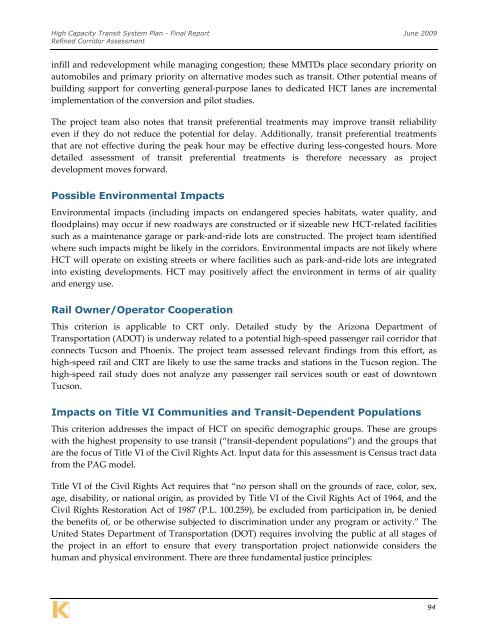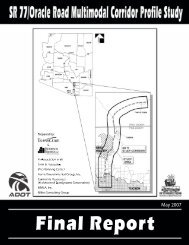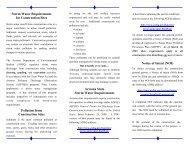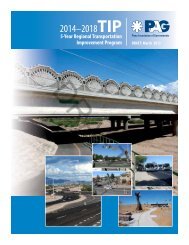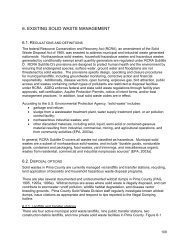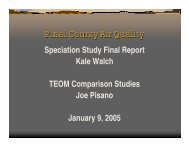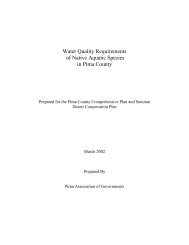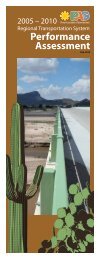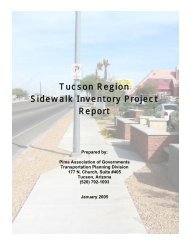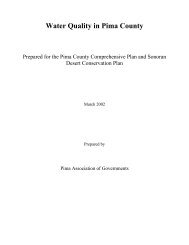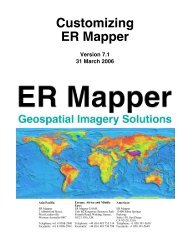Final Report - Pima Association of Governments
Final Report - Pima Association of Governments
Final Report - Pima Association of Governments
You also want an ePaper? Increase the reach of your titles
YUMPU automatically turns print PDFs into web optimized ePapers that Google loves.
High Capacity Transit System Plan - <strong>Final</strong> <strong>Report</strong> June 2009<br />
Refined Corridor Assessment<br />
infill and redevelopment while managing congestion; these MMTDs place secondary priority on<br />
automobiles and primary priority on alternative modes such as transit. Other potential means <strong>of</strong><br />
building support for converting general‐purpose lanes to dedicated HCT lanes are incremental<br />
implementation <strong>of</strong> the conversion and pilot studies.<br />
The project team also notes that transit preferential treatments may improve transit reliability<br />
even if they do not reduce the potential for delay. Additionally, transit preferential treatments<br />
that are not effective during the peak hour may be effective during less‐congested hours. More<br />
detailed assessment <strong>of</strong> transit preferential treatments is therefore necessary as project<br />
development moves forward.<br />
Possible Environmental Impacts<br />
Environmental impacts (including impacts on endangered species habitats, water quality, and<br />
floodplains) may occur if new roadways are constructed or if sizeable new HCT‐related facilities<br />
such as a maintenance garage or park‐and‐ride lots are constructed. The project team identified<br />
where such impacts might be likely in the corridors. Environmental impacts are not likely where<br />
HCT will operate on existing streets or where facilities such as park‐and‐ride lots are integrated<br />
into existing developments. HCT may positively affect the environment in terms <strong>of</strong> air quality<br />
and energy use.<br />
Rail Owner/Operator Cooperation<br />
This criterion is applicable to CRT only. Detailed study by the Arizona Department <strong>of</strong><br />
Transportation (ADOT) is underway related to a potential high‐speed passenger rail corridor that<br />
connects Tucson and Phoenix. The project team assessed relevant findings from this effort, as<br />
high‐speed rail and CRT are likely to use the same tracks and stations in the Tucson region. The<br />
high‐speed rail study does not analyze any passenger rail services south or east <strong>of</strong> downtown<br />
Tucson.<br />
Impacts on Title VI Communities and Transit-Dependent Populations<br />
This criterion addresses the impact <strong>of</strong> HCT on specific demographic groups. These are groups<br />
with the highest propensity to use transit (“transit‐dependent populations”) and the groups that<br />
are the focus <strong>of</strong> Title VI <strong>of</strong> the Civil Rights Act. Input data for this assessment is Census tract data<br />
from the PAG model.<br />
Title VI <strong>of</strong> the Civil Rights Act requires that “no person shall on the grounds <strong>of</strong> race, color, sex,<br />
age, disability, or national origin, as provided by Title VI <strong>of</strong> the Civil Rights Act <strong>of</strong> 1964, and the<br />
Civil Rights Restoration Act <strong>of</strong> 1987 (P.L. 100.259), be excluded from participation in, be denied<br />
the benefits <strong>of</strong>, or be otherwise subjected to discrimination under any program or activity.” The<br />
United States Department <strong>of</strong> Transportation (DOT) requires involving the public at all stages <strong>of</strong><br />
the project in an effort to ensure that every transportation project nationwide considers the<br />
human and physical environment. There are three fundamental justice principles:<br />
94


